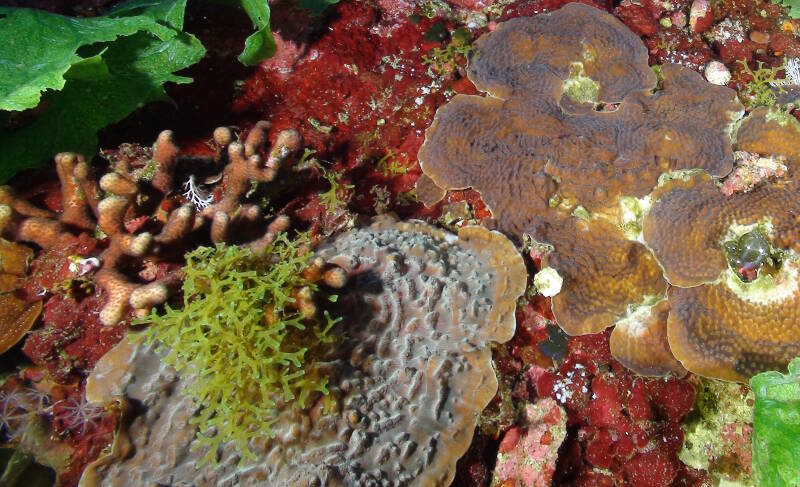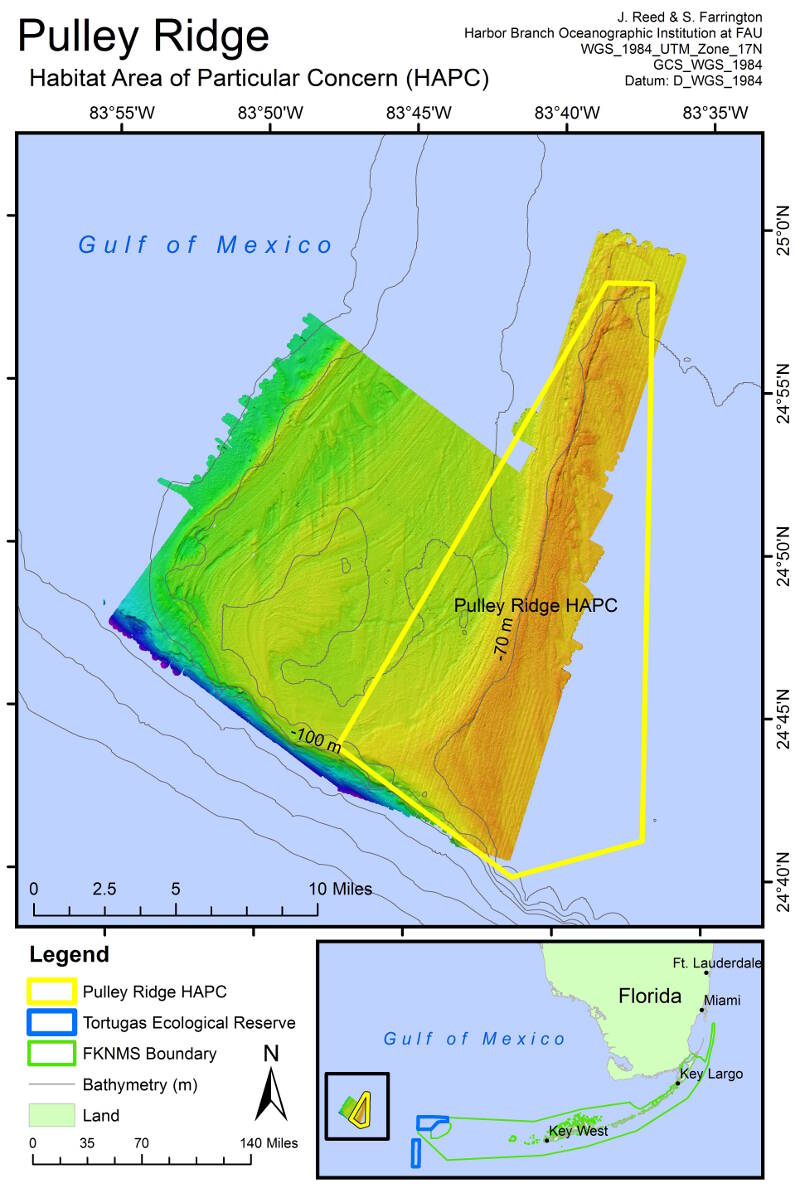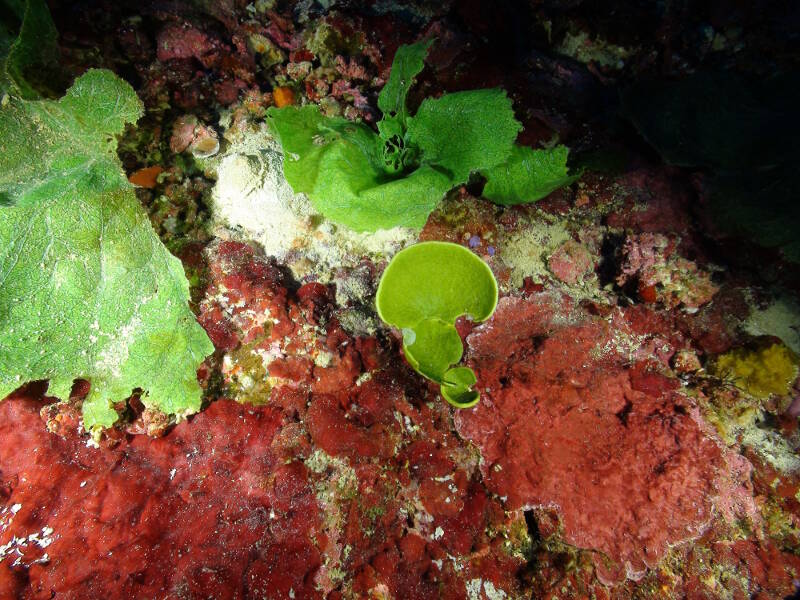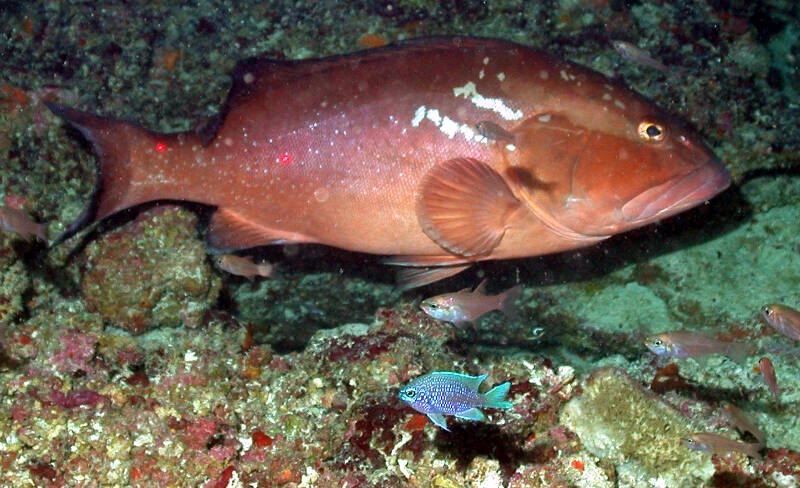
By Stephanie Farrington, Research Biologist
and John Reed, Research Professor
The Cooperative Institute for Ocean Exploration, Research, and Technology
Robertson Coral Reef Research and Conservation Program
Harbor Branch Oceanographic Institute at Florida Atlantic University

Figure 3. Example of corals and algae found on Pulley Ridge: The plate corals Leptoseris cucullata (foreground) and Agaricia fragilis; the finger coral Madracis sp.; the leafy green algae Anadyomene menziesii; and the branching algae Dictyota sp. Image courtesy of Mike Echevarria, Florida Aquarium. Download larger version (jpg, 1.8 MB).
Pulley Ridge is the deepest known photosynthetic coral reef off the continental U.S. Located in the Gulf of Mexico; it lies approximately 66 km west of the Dry Tortugas at the far end of the Florida Keys. Originally discovered in 1950, Pulley Ridge is approximately 300 kilometers in length and 15 kilometers wide.

Map of Pulley Ridge Habitat Area of Particular Concern showing multibeam sonar. Image courtesy of John Reed and Stephanie Farrington, Harbor Branch Oceanographic Institute at Florida Atlantic University. Download larger version (jpg, 3.3 MB).
Only the southernmost 30 kilometers of Pulley Ridge represents a drowned barrier island with photosynthetic corals living between 60 to 75 meters in depth. The dominant communities in these reefs, also known as mesophotic coral ecosystems, are coralline algae and scleractinian corals. Fish species present at Pulley Ridge represent a mix of both shallow and deep water species.
According to the U.S. Geological Survey , the coral on Pulley Ridge was “considerably healthier then coral from shallow water reefs nearly worldwide.” With the well-documented decline of coral reefs in the Florida Keys, the health of reefs on Pulley Ridge provided hope that these reefs may be able to help replenish shallower reefs in the Florida Keys.
Pulley Ridge was designated a Habitat Area of Particular Concern in 2005 by the Gulf of Mexico Fishery Management Council. It is protected from fishing using bottom trawls, longlines, buoy gear, and traps/pots. (For more information on management, see Pulley Ridge: Looking Upstream.)

Some of the species of algae found on Pulley Ridge: unidentified red coralline, leafy green Anadyomene menziesii, and the green calcareous Halimeda tuna. Image courtesy of Mike Echevarria, Florida Aquarium. Download larger version (jpg, 4.7 MB).
Southern Pulley Ridge has an array of photosynthetic hard corals, macroalgae, sponges, and reef fishes. Based on photographs collected by USGS, Pulley Ridge is dominated by hard coralline algae, which covers 45-65 percent of the seafloor. It is also home to a wide variety of fleshy macroalgae including Halimeda tuna, Dictyota sp., Kallymenia sp., and the endemic species Anadyomene menzeisii, which looks like a large head of lettuce and can be as dense as tens of plants per square meter.

Red grouper Epinephelus morio in pit with purple reef fish Chromis scotti on Pulley Ridge. Image courtesy of the University of North Carolina at Wilmington, National Undersea Research Center. Download larger version (jpg, 495 KB).
The two most abundant species of scleractinian corals are Agaricia spp. and Leptoseris cucullata, which form flat plates as large as 50 centimeters in diameter. These species are typically found only on the deeper slopes of shallow water reefs in the Caribbean and Florida. Montastraea cavernosa (the giant star coral), also found on Pulley Ridge, is common on shallow water reefs.
Pulley Ridge is home to more than 60 species of shallow and deep reef fish species, including the commercially important species Epinephelus morio – the red grouper. Red grouper form large 6-10 meters wide pits in the sand and rubble bottom that provide shelter like an oasis for numerous smaller reef fish.
For more information on Pulley Ridge, see http://coastal.er.usgs.gov/pulley-ridge/index.html.